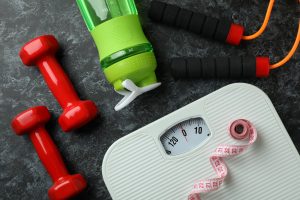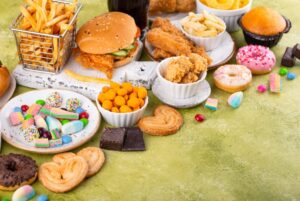Healthy eating doesn’t have to start with weighing every gram of food or tracking every calorie. The fastest, most sustainable way to feel better, reduce daily calorie intake, and steadily lose fat is to simplify the inputs: eat mostly whole foods, prioritize protein, and build habits one step at a time. This article presents a clear plan that uses only a portion of the source discussion, adds evidence and practical tactics, and avoids extremes.
Why “Simple First” Beats “Perfect Now”
Ambitious overhauls often fail because they require too many new behaviors at once. A simpler approach—cleaner food choices, one or two consistent meals, and basic strength work—delivers early wins without overwhelming effort. As appetite, energy, and cravings improve, additional structure (like macro tracking) can be layered in later if needed for specific goals.
Key idea: Start with the easiest, highest-impact changes: swap ultra-processed foods for whole foods, and ensure each meal includes a meaningful source of protein.
Whole Foods vs. Ultra-Processed: The Satiety Advantage
Ultra-processed foods are typically calorie dense, easy to overeat, and designed to be hyper-palatable. In controlled research, people spontaneously consumed more calories on an ultra-processed diet than on a minimally processed diet when allowed to eat as much as they wanted—despite similar menus in appearance and taste. That extra intake led to weight gain within weeks. Authoritative overviews from the U.S. National Institutes of Health summarize these effects and reinforce the practical takeaway: minimizing ultra-processed items tends to reduce calorie intake without deliberate restriction. NIH Research Matters summary.
Energy Density and Volume
Whole foods (fruit, vegetables, legumes, lean proteins, whole grains) usually provide more volume for fewer calories. That increased volume stretches the stomach, engages stretch and nutrient receptors, and contributes to the feeling of fullness. Practically speaking, a bowl of berries, a large salad with lean protein, or a hearty bean-and-veg soup can offer satisfying portions with far fewer calories than a small serving of chips or sweets.
| Food | Typical Portion | Approximate Calories | Satiety Impact (Qualitative) |
|---|---|---|---|
| Potato chips | 1 small bag (42 g) | ~220 | Low (easy to overeat) |
| Blueberries | 2 cups (~296 g) | ~170 | Moderate (high volume, fiber) |
| Skinless chicken breast, cooked | 8 oz (~226 g) | ~375 | High (protein-rich) |
Illustrative values only; actual calories vary by brand and preparation.
Prioritize Protein to Protect Muscle and Control Hunger
Protein is the most satiating macronutrient and is essential for preserving lean muscle—especially when body weight is dropping. Practical daily targets for many adults seeking fat loss fall roughly in the range of 0.7–1.0 g per pound of goal body weight (about 1.6–2.2 g/kg), adjusted for individual size, training volume, and preferences. Even without tracking calories, a habit of including 25–40 g of protein at each main meal can dramatically improve fullness and recovery from training.
Easy Protein Anchors
- Poultry: grilled chicken or turkey
- Lean beef or bison: 90–96% lean
- Eggs and egg whites: mix to preference
- Dairy: Greek yogurt, cottage cheese
- Seafood: tuna, salmon, cod, shrimp
- Plant proteins: tofu, tempeh, lentils, edamame
Hit protein first, then fill the plate with high-volume produce and a modest serving of minimally processed carbohydrates (e.g., potatoes, rice, oats, beans, whole-grain pasta), plus a thumb or two of healthy fats as needed for flavor and satisfaction.
Strength Training: The Metabolic Safeguard
As body weight declines, some lean tissue loss is common unless it is actively protected. Regular resistance training signals the body to maintain muscle and functional strength. This is especially important with aging, when muscle naturally declines if not challenged. A trusted overview from the National Institute on Aging outlines how strength training supports mobility, independence, and metabolic health throughout the lifespan. NIA exercise guidance.
Minimum Effective Dose
- Train 2–3 days per week covering major movement patterns (squat, hinge, push, pull, carry).
- Perform 2–4 sets of 6–15 reps per exercise with good form.
- Progress gradually: add reps, load, or sets as technique allows.
Even brief, consistent sessions paired with adequate protein can preserve or build muscle while fat is lost.
A Step-By-Step Plan You Can Start Today
The following staged approach relies on habit sequencing—changing one lever at a time until your routine becomes automatic. Each step can last a week or two before adding the next.
Step 1: Clean Up Breakfast
Choose a protein-anchored breakfast that you enjoy and can repeat most days. Examples: Greek yogurt with berries and a sprinkling of oats; a veggie omelet with a side of fruit; cottage cheese with pineapple and whole-grain toast; overnight oats with added whey or plant protein. Keeping one breakfast “template” dramatically reduces decision fatigue.
Step 2: Fix Snacks
Replace ultra-processed snacks with purposeful options: a protein shake and an apple; hummus and carrots; beef jerky and grapes; a handful of almonds with a clementine; cottage cheese and cherry tomatoes. Keep them visible and easy to grab.
Step 3: Make Lunch Mostly Whole Foods
Center lunch on a lean protein, a big serving of vegetables, and a smart carb: grilled chicken burrito bowl; tuna and bean salad with greens; turkey, avocado, and tomato on whole-grain bread with a side salad; lentils over quinoa with roasted veg.
Step 4: Right-Size Dinner Portions
Use a simple plate method: half non-starchy vegetables, a palm or two of protein, a cupped-hand of minimally processed carbs, and a thumb of fat. Slow down at the table; set utensils down between bites, and stop at “satisfied,” not stuffed.
Step 5: Hydration and Sleep
Drink water regularly and aim for a consistent sleep window. Both affect appetite regulation, training quality, and recovery. A well-rested brain is better at saying “no” to impulse foods.
Smart Swaps That Cut Calories Without Counting
- Swap chips → air-popped popcorn, raw veggies with salsa, or fruit.
- Swap sugary soda → sparkling water, unsweetened tea, or diet soda if needed as a bridge.
- Swap refined pasta → whole-grain pasta or higher-protein legume pasta with extra vegetables.
- Swap heavy dressings → vinaigrettes measured by the spoon or yogurt-based dressings.
- Swap pastries → Greek yogurt parfaits or protein-fortified overnight oats.
Protein Awareness Without Full Tracking
You don’t have to weigh everything to have a good sense of intake. Learn a few reference points so you can estimate on the fly:
- Cooked chicken breast (4 oz): roughly 30–35 g protein
- Eggs: ~6–7 g per egg; egg whites add protein with minimal fat
- Greek yogurt (1 cup, nonfat): ~20 g protein
- Canned tuna (one 5 oz can, drained): ~20–25 g protein
- Firm tofu (4 oz): ~10–12 g protein
Build each meal around one of these anchors, and daily totals often land in a productive range without meticulous logging.
Managing Cravings and the “Teeter-Totter” of Choices
Total restriction isn’t required. Many people succeed by allowing a favorite indulgence strategically—for example, once per week, after a protein-dense meal, and portioned in advance. This keeps the plan psychologically sustainable while preventing a slide back into ultra-processed patterns. Think of it as a teeter-totter: the more whole foods and movement on one side, the more room for occasional treats on the other.
Common Pitfalls (and Fixes)
“I’m starving at night.”
Add more protein and produce at lunch; include a structured afternoon snack. Consider a later protein shake or Greek yogurt if training in the evening.
“Weekends erase my weekday progress.”
Pre-decide two flexible, higher-calorie meals and keep the rest of the weekend consistent. Walk after those meals and resume normal breakfast the next day.
“I travel or eat out a lot.”
Use the same plate method in restaurants. Ask for sauces on the side, choose grilled or baked proteins, and double the vegetables. If portions are huge, box half before starting.
Putting It Together: A Sample Day
Breakfast: Greek yogurt (1 cup) with berries and a sprinkle of oats; coffee or tea. Snack: Protein shake and an apple. Lunch: Big salad with mixed greens, tomatoes, cucumbers, chickpeas, grilled chicken, vinaigrette measured by the spoon; whole-grain roll. Snack: Cottage cheese with pineapple. Dinner: Stir-fry with extra vegetables, tofu or lean steak, and a modest portion of rice; fruit for dessert. Training: 30–45 minutes of full-body strength work, 2–3 days per week; add easy walks on non-training days.
When (and Whether) to Track
Food logging is a tool, not a rule. It’s useful when progress stalls, when precision is needed for a deadline (e.g., a photoshoot or competition), or to learn the calorie and macro profile of favorite meals. For general health and steady fat loss, many people do well with the simpler playbook: whole foods, protein at each meal, routine strength training, and consistent sleep.
Evidence Corner
- Controlled feeding studies show that ultra-processed diets can drive higher calorie intake and short-term weight gain compared with minimally processed diets. See the NIH summary: Ultra-processed diet leads to eating more and gaining weight.
- Strength training supports healthy aging, function, and metabolic health. See the National Institute on Aging overview: Exercise & Physical Activity.
Video Summary
For more evidence-based nutrition and fitness tips, subscribe to our channel: https://www.youtube.com/@Vitality-and-Wellness
Looking for extra help with your fitness goals? Check out the personalized Nutrition Program at Parkway Athletic Club: parkwayathleticclub.com/nutrition
Disclaimer: This content is for educational purposes and does not replace personalized medical advice.



